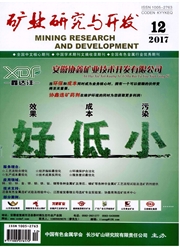

 中文摘要:
中文摘要:
基于地应力现场实测结果的复杂性、随机性和不完备性,为提高对测试数据分析的可靠性,针对金川矿区实测的地应力数据,采用人工神经网络模型对实测数据进行学习和训练,由此建立了矿区地应力分布规律与影响因素之间的隐函数关系。然后通过不同位置和深度的地应力预测和回归分析,获得了金川矿区复杂地应力场的变化规律。研究结果表明:随着埋藏深度的增加,金川矿区的最大水平主应力σH、最小水平主应力σh和垂直主应力σV大致呈现线性变化关系;垂直主应力随深度的线性回归系数为0.0285,基本上等于或略大于于上覆岩层的重量;浅部以水平应力为主,深部地应力逐步向静水压力场发展;但深部的剪应力随深度逐渐增大,并对地下工程稳定性产生不利影响。研究结果为金川矿区深部工程优化设计和矿体开采提供了理论依据。
 英文摘要:
英文摘要:
In order to overcome the complexity,randomicity and incompleteness of the measured in-situ stress results and improve the reliability of data analysis,an artificial neural networks model was established to study and practice on measured geo-stress in Jinchuan mining area.Thus,an implicit function relationship between distribution of in-situ stress and influencing factors was built.Then,the changing laws of in-situ stress in Jinchuan mine were obtained by stress prediction and regression analysis in different position and depth.The research showed that there was an approximate linear relationship between the burial depth with the maximum horizontal principal stress,the minimum horizontal principal stress and the vertical principal stress.The linear regression coefficient between the vertical principal stress and the depth was 0.0285,nearly equal to or slightly larger than the weight of the overburden.Horizontal stress was the main stress in shallow rocks,but the stress in deep gradually developed to hydrostatic field.The deep shear stress rising with the increase of depth had adverse effect on the stability of underground engineering.The study results had provided theoretical basis for optimal design of deep engineering and mining in Jinchuan mining area.
 同期刊论文项目
同期刊论文项目
 同项目期刊论文
同项目期刊论文
 期刊信息
期刊信息
